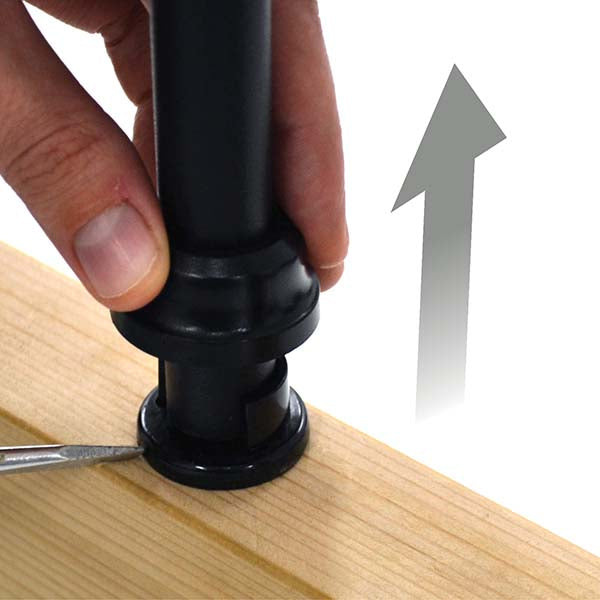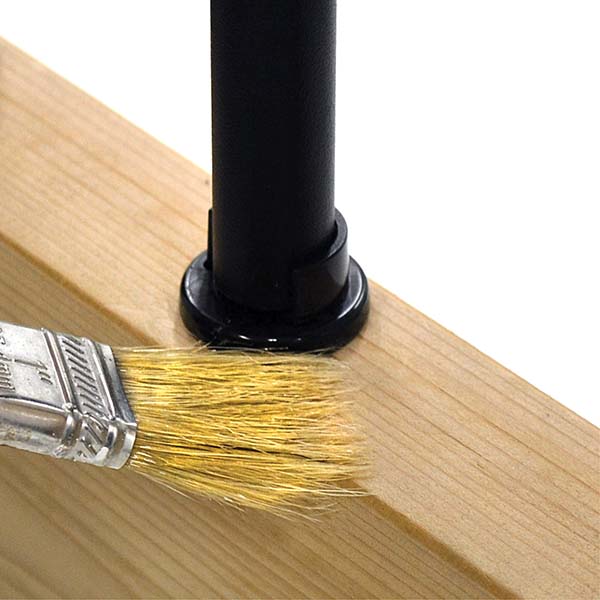Menu
Your cart is empty
Looks like you haven't added anything to your cart yet
ANYONE CAN INSTALL BALUSTERS TWICE AS FAST
Snap'n Lock™ Stair Adapter Plus Connector Packs include everything you need to build a stair - except the balusters themselves. You get the Stair Adapters and horizontal Snap'n Lock™ Connectors and screws in one convenient pack. So you can use our connectors with other manufacturers 3/4" round aluminum balusters if you wish. Here's what you get:
- (20) Snap'n Lock™ round baluster connectors
- (20) Snap'n Lock™ round stair adapters
- (20) Screws
- Covers 4' of railing
The connectors are made with 100% USA poly carbonate. They are bullet proof, handle extreme temperatures and UV rays. Who says we can't make the best products right here at home!
SIDEWAYS INSTALLATION IS A SNAP!
It's so simple that even folks who are just starting out can do it themselves with minimal carpentry experience.
+ Installs faster and easier than plug style systems.
+ Simple, carefree maintenance.
+ Easily retrofit old 2x2 wood railings without dismantling the existing railing.
+ You will love the elegant architectural style and design.
HOW IT WORKS

SCREW
Screw the base into the 2x4.

SNAP
Snap in the baluster.

LOCK
Slide down and lock the collar.
BUILDING STAIR RAILS WITH SNAP LOCK BALUSTER STAIR ADAPTERS
Let's take a closer look at how the stair adapters work with the Snap Lock Balusters connectors.
No need to cut balusters at an angle.
Just snap the adapter to the underside of the base connector and screw the unified parts to the 2x4 as normal.
This helpful visual guide is worth a thousand words and shows just how simple it is.
The shorter 25" balusters are recommended for most common stair rail applications as shown in the diagram.

INSTALLING A COMMON 36" TALL STAIR RAIL
Here is one way to build your stair rail using Snap'n Lock Stair Adaptors and Shadow Rail Connectors.
The elevation contact points for the 2x4 rail connectors depict one possible configuration resulting in the top rail meeting the newel post at 36" above the deck surface.
The gap between the underside of the lower rail and the surface of the treads may permit a 6" ball to fit underneath but never greater. The bottom rail may be set lower to the nosing of the tread if desired.

The angle of typical code compliant stairs ranges between 34°-35°. Baluster lengths shown here assume the Snap'n Lock connector and stair adapters are used. Baluster lengths may vary if the angle changes but rarely exceed 25".

The adapters are set at 35 degrees to match the common rise and run for stairs under the residential code.
But sometimes you might have a slightly shorter rise and a longer run. This changes the angle slightly and can differ from the 35-degree default.
Don't worry. They have enough flex to accommodate stairs from 33 to 38 degrees.
PRODUCT INSTALLATION GUIDES

Snap'n Lock Baluster Instructions
Save time and effort by using our Snap’n Lock Baluster Kits for your next railing.
Whether you’re retro-fitting or starting a new project, they’ll make building your railing a snap, even by yourself.
WHY IT WORKS

Do not let the simple look of the Snap 'n Lock™ Balusters fool you. A lot of thought went into conceiving this design in order to make it work so well. The base and the collar are designed to incredibly tight tolerances so they fit together like a glove and constrict around the baluster to hold it tight eliminating any wobble.
The sidewalls of the base are free to flex and accept the baluster as it is pushed in place. The mating surfaces of the base and the collar are sloped so that as they slide together the fit gets tighter and tighter until they lock together once fully seated.
The parts can be released by fitting a slot screwdriver under the color and popping it up. This allows for easy maintenance or the addition of decorative baluster collars anytime after installation.
SNAP'N LOCK™ BALUSTERS ARE PERFECT FOR RETROFITTING OLD WOOD RAILINGS
Replace old worn 2x2 wood pickets with Snap'n Lock™ Balusters without having to dismantle the entire railing.
Sideways installation makes this possible!

STEP 1

STEP 2

STEP 3

STEP 4
With traditional plug systems, you have to take down the entire railing and rebuild from scratch.
Make sure to measure the gap between your upper and lower 2x4 rails and pick the 25" or 31" and then cut them down to your specific gap less 1/2" for the thickness of the base connectors.
Aluminum is so easy to cut and is not subject to oxidization the same way ferrous metals are.
This saves you a lot of time and money. But the best thing is that you just gave your old worn out wood railing a brand new life.
FAST AND EASY MAINTENANCE

POP COLLAR UP
The collar releases using a slot screwdriver.

STAIN OR PAINT
Stain or paint around the base quickly and easily. No need to use tape.

LOCK COLLAR DOWN
Just slide and lock the collar down when you are done.
- Choosing a selection results in a full page refresh.




































